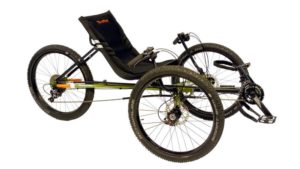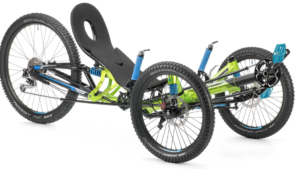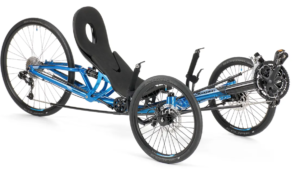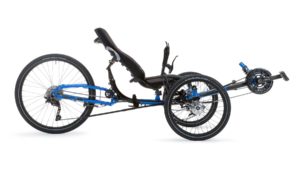Streamlined Aero Dynamics
At 20 mph, 80% of an ordinary bike rider’s energy goes into pushing the air aside. This is what makes it so much harder to ride into a headwind, than a tailwind. On the Aero, you’ll LOVE headwinds! Because when you turn into a headwind on the Aero, you will leave the competition behind, if you haven’t already. Even the cross member on the Aero is streamlined. This is because a streamlined tube has 1/10th the drag of a round tube! The more the seat is reclined, the smaller your frontal area is to the wind and the faster you go. The seat of the Aero is reclined at a low 20 degrees. Wind tunnel testing shows a large gain in speed when using wheel covers. Most bikes and trikes cannot use front wheel covers due to instability in crosswinds. The Aero overcomes this and further reduces drag by using 16” front wheels with a 20” rear wheel.
To further reduce air drag, the Aero uses the joystick steering that was first used on the SLR. This is linear action steering, allowing the hands and arms to be closer to the body, moving fore and aft, instead of moving sideways, where your arms catch more wind. The cranks are above the seat, so that the feet are within the frontal area for the body, reducing air drag. Our wind tunnel testing has shown that the exposed calipers on disk brakes produce more drag than drum brakes, where the drum is contained within the wheel. So the Aero uses special 90 mm drum brakes which have been reduced in overall width to fit within the wheel slim wheel covers. Finally, there is a new headrest available if needed. It has a single support strut, in line with the neck, instead of the two struts on previous headrests.
Light Weight
While weight has less of an effect on performance than aerodynamics, every aspect of the Aero has been examined for weight reduction. This starts with the frame. The frame of the Aero is non-folding, plus the seat frame is an integral part of the mainframe so the weight of hinges and other joints and fasteners are eliminated. Plus the frames are mutually re-enforcing, and thus the whole structure can be lighter and more aerodynamic.
We have used 7005 aluminum alloy for the Aero. This has reduced the weight of the frame by over 3 pounds, or 30% over the Cro Mo 4130 prototypes. Although the axle size has been increased from the 12mm of the SLR to 15mm on the Aero to reduce axle flex, the weight of the kingpins has been reduced, as has the front hubs, by totally removing the outer flange. Even the weight of the special GreenSpeed Scorcher tires has been reduced for the Aero. Thus you will notice how quickly the Aero accelerates with the first stroke of the pedals.
Rolling Resistance
There is a myth in the cycling world that the larger the wheel, the easier it will roll. This is a carryover from the horse and carriage days when the larger wheels would sink less into soft ground and a larger steel tired cartwheel would roll easier over a certain size stone. This changed forever with the advent of sealed roads and the pneumatic tire.
There is also a myth that thinner tires roll faster. In laboratory testing at GreenSpeed, on many different types and sizes of tires, it was discovered that not only did smaller diameter tires roll easier than large ones of the same construction and pressure, but wider tires rolled easier than narrow ones. Plus certain types of tire construction rolled easier than others. This lead to the design and manufacture of the GreenSpeed Scorcher tires, which have been the number one choice of the top Australian racing teams for the last 10 years.
For the Aero, we have taken another look at the design of the Scorchers and managed to further improve the rolling resistance by an extra 15%! When you stop pedaling the Aero and coast, you will be surprised at how easily it rolls.
Top Gearing
On a Penny Farthing bicycle, the larger the front driving wheel, the faster it went. This was because there was no gearing and it was direct drive. The ground covered with each wheel revolution was dependent on the size of the wheel, which was dependent on the length of the rider’s legs. Then the Safety came along with the smaller wheels and gearing, so everything changed. However, the myth that larger wheels are faster persists to this day.
This myth is perpetuated by the use of gearing designed for bikes with 26” and 700c wheels which are fitted to many trikes with 20” wheels. This results in gearing which is far too low for speed. Thus instead of the standard 50/39/30 cranksets and 11/32 cassettes fitted to many trikes, the Aero has a 56/42/28 crankset and a 9/28 ten-speed cassette. This gives a top gear of 20 x 56/9 = 124 inches, V 20 x 50/11 = 91 inches for a standard 20” wheeled trike, or 26 x 50/11 = 118 inches for a standard trike with 26” rear wheel. The Schlumpf Mountain Drive is a popular alternative to the triple, and with the standard 60t ring and the 9/28 cassette, it will give a range from 17 to 133 inches. Thus on the Aero, you can be sure you will be faster than a trike with a 26” or 700c rear wheel. Plus the Aero will handle better due to less rear end flex.
<!–
Specifications
[su_row][su_column size=”1/2″ center=”no” class=””]
- Frame: Aluminium Alloy 7005
- Width: 30″
- Length: 80”
- Height: 20″
- Seat Height: 6.5”
- Seat Angle: 20˚
- Crank Height: 12.5 to 14.7”
- X-Seam Range: 39 to 47”
- Ground Clearance: 2.6″
- Turning Radius: 14′
- Wheelbase: 41.3”
- Wheels: 16” & 20″ Alloy rims with SS spokes and carbon fibre covers
[/su_column] [su_column size=”1/2″ center=”no” class=””]
- Tires: GreenSpeed Slicks, 16” x 1 ½” & 20” x 1.5”
- Gears: 30
- Cranks: Shun SS-ZO-300 56/42/28 x 165 mm
- Cassette: 10 speed 9/28
- Derailleur: Shimano 105
- Chain: YBN S10
- Shifters: Shimano Dura Ace Bar End
- Gear Range: 18 to 124” – 689%
- Brakes: Sturmey Archer 90mm Drums
- Weight Limit: 250 lbs
- Trike Weight: 31lbs
- Standard Equipment: Carbon fibre wheel covers
[/su_column][/su_row]
–>








Reviews
There are no reviews yet